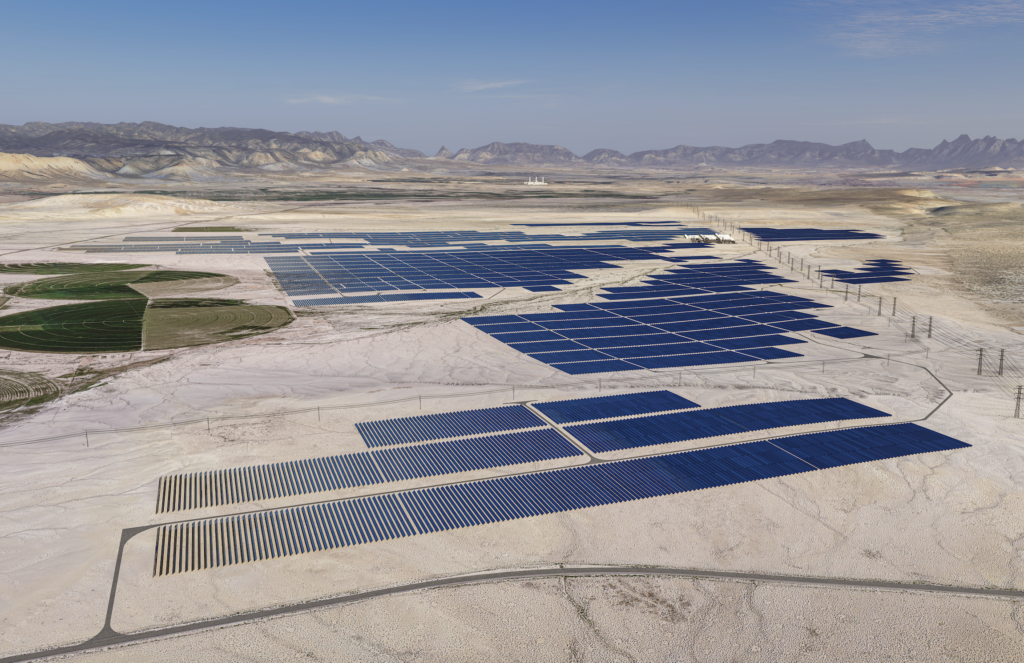Rendering of the Green River Energy Center, one of the country’s largest solar and storage projects. (Courtesy of rPlus Energies)
Sunny skies and high elevations led a Utah company to build one of the country’s largest solar and storage facilities in the east-central portion of the state. The structure is expected to generate enough electricity to power about 88,000 Utah homes and to store solar power for peak hours.
The Green River Energy Center, located near Ferron in Emery County on a relatively flat site with about 300 days of sunshine, is set to generate 400 megawatts and is able to store that capacity for four hours for a total of 1,600 megawatts.
“We really think that this project helps diversify Utah’s energy mix and is complementary to the other generation that’s already on the system. And with Utah being a growth market where the load demand is increasing, we think this is a great place to do business, and we will successfully build and deliver this project, and hope to build many others in the state of Utah,” said Theresa Foxley, chief of staff at rPlus Energies, the developer of the project.
GET THE MORNING HEADLINES DELIVERED TO YOUR INBOX
The center contracted with PacifiCorp to manage the transmission system. A lot of the energy will be consumed locally in the state, Foxley said, but the structure will serve the whole PacifiCorp network, which encompasses six Western states.
The storage capacity will help with the roadblocks that intermittent sources, such as solar, encounter — supplying clean energy when the sun isn’t shining, which, simultaneously, is often when households experience their highest energy demands.
Emery County isn’t only an ideal location for these types of projects because of its geography, but because of its energy producing legacy alongside Carbon County, Foxley said. The site has access to transmission lines in addition to vendors and a workforce ready to support the project.
While the state discusses a potential 18.1% residential rate increase for power, mostly attributed to soaring fuel and wholesale power costs, solar energy prices have declined significantly. This generation would add to PacifiCorp’s energy mix and could help keep prices competitive, Foxley said.
“The beauty of solar is that once it’s installed, you’re not subject to fuel volatility, as we are with other sources of energy, thermal energy in particular,” she said. “So there’s an upfront cost, of course, to building and constructing these facilities, but the ongoing operation and maintenance costs of them are very low, and we believe that it provides a really cost-competitive and diversified form of energy for the consumer.”
The project has a $1.1 billion price tag, has been in the works for about eight years and is scheduled to start commercial operations in May of 2026, Foxley said.
During the peak of its construction, rPlus Energies is expected to create 500 jobs. The company committed to hire as many local residents as possible to build the internal roads within the project and other battery installation and substation developments.
Once the project is ready, because of its low-cost nature, the ongoing headcount to support the projects is about 15 to 20 full-time employees a year, Foxley said.
Officials during the groundbreaking ceremony of the Green River Energy Center, one of the country’s largest solar and storage projects on Thursday, Sept. 19, 2024. (Courtesy of rPlus Energies)
“We are proud to be working with those communities to continue their legacy of energy exportation through utilizing a lot of the existing infrastructure there that has has historically moved electrons that were generated by coal fired power plants and will continue to move electrons generated by coal fired power plants, but adding on this new solar and this storage capacity, which really helps provide grid stability,” Foxley said.
And, though its contract with PacifiCorp will run for 20 years, the equipment has a longer lifespan. As western markets continue to attract large energy consumers, such as tech manufacturers and data centers, Foxley said, it’s an interesting time for energy in Utah.
“We can not only have this electricity generated in Utah to help facilitate additional economic activity throughout the state and to allow our country to be more competitive economically,” Foxley said. “But that also has this ancillary benefit of a large capital investment project in a smaller rural community, for whom this capital investment will represent some $55 million in local tax revenue over a 20-year period.”
During a groundbreaking ceremony on Thursday, the Emery High marching band, a rodeo queen on her horse, an archery club and Utah Gov. Spencer Cox welcomed the project to the community.
“This project is being built in rural Utah, by rural Utahns, and for all of Utah. When rural Utah thrives, the entire state prospers,” Cox said at the groundbreaking, according to a news release. “Today, we’re not just breaking ground — we’re building a future of affordable, abundant energy in Utah.”
SUPPORT NEWS YOU TRUST.

